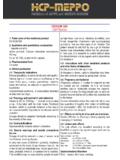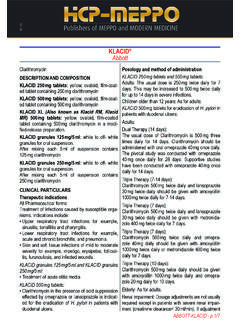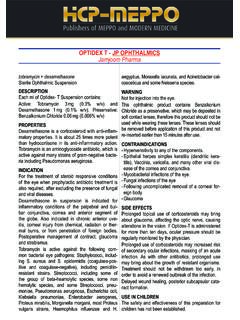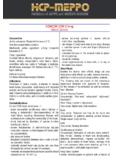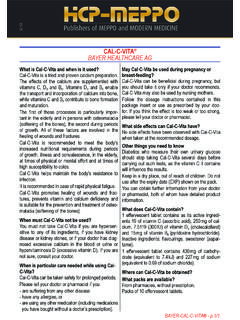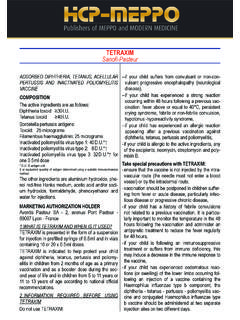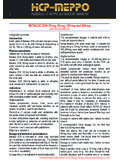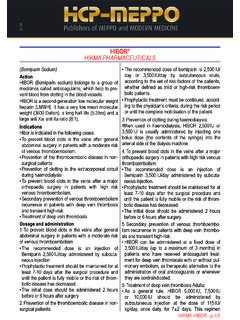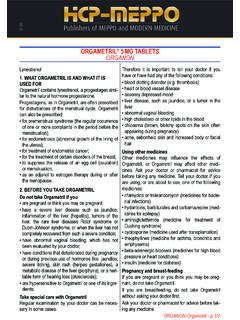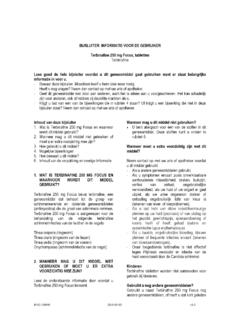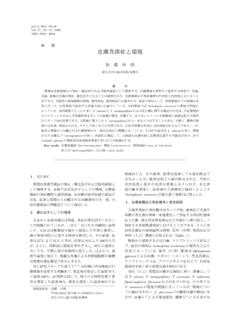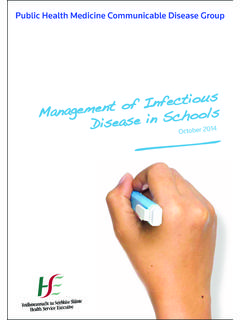Transcription of QUADRIDERM* Cream Schering-Plough
1 Results of the Draize cutaneous patch test in 100 patients indicated that gentamicin was not a primary irritant; furthermore, gentamicin has a low index of skin is a potent fungicidal agent against Trichophyton mentagrophytes, Trichophyton rubrum, Microsporum canis, Epidermophyton floccosum and Malassezia furfur. Clinical studies have shown the excellent fungicidal effect of tolnaftate in a large number of patients with superficial fungal Therapy with tolnaftate has been notable for lack of recurrence. Tests of skin sensitivity have shown no signs of local irritation 24 and 48 hours after medica-tion was applied. Clioquinol is effective topical therapy for bacte-rial and/or candidial (monilial) infections. Inhibition of Candida albicans was obtained with concentra-tions of 25 mcg/ml.
2 At concentrations of 50 mcg/ml clioquinol completely /inhibited all four strains of Candida albicans component of QUADRIDERM Cream makes a significant contribution to the efficacy of the product in treating infections of mixed AND USAGEQUADRIDERM Cream is indicated for the relief of the inflammatory manifestations of corticosteroid-responsive dermatoses when complicated by sec-ondary infection caused by organisms sensitive to the components of this dermatologic preparation or when the possibility of such infection is disorders include: inguinal dermatosis, chronic dermatitis of the extremities, erythrasma, balanopos-thitis, herpes zoster, eczematoid dermatitis, contact dermatitis, follicular dermatitis, dyshidrosis, paronychia, anal pruritus, seborrheic eczema, intertrigo, seborrhe-ic dermatitis, pustular acne, impetigo, neurodermatitis, angular stomatitis, photosensitivity dermatitis, licheni-fied inguinal dermatophytosis and tinea infections such as tinea pedis, tinea cruris and tinea of betamethasone valerate, gentamicin sul-fate, tolnaftate and clioquinolFOR DERMATOLOGIC USE ONLYDESCRIPTIONEach gram of QUADRIDERM Cream contains betamethasone valerate equivalent to mg beta-methasone, gentamicin sulfate equivalent to mg gentamicin, 10 mg tolnaftate and 10 mg clioquinol [iodochlorhydroxyquin]
3 In a paraben- and lanolin-free water washable Cream base containing chlorocresol as a preservative. Inactive ingredients: Chlorocresol, monocetyl ether of polyethylene gly-col, white petrolatum, sodium phosphate, and puri-fied Cream combines the anti-inflam-matory, antipruritic and vasoconstrictive agent beta-methasone valerate, the wide-spectrum antibiotic gentamicin sulfate, the fungicidal agent tolnaftate and clioquinol, an antibacterial and antifungal PHARMACOLOGYC linical studies have demonstrated the efficacy of betamethasone valerate in the treatment of cortico-steroid-responsive betamethasone valerate was subjected to the Draize patch test, no primary irritation or potential for allergic contact dermatitis vitro antibacterial activity of gentamicin showed it to be bactericidal against a wide variety of gram-positive and gram-negative bacteria.
4 At concentra-tions of 4 mcg/ml or less, gentamicin inhibited 95% of strains of Staphylococcus aureus and 70-90% of strains of Escherichia coli and Aerobacter studies in animals and man revealed no evi-dence of skin irritation after local application of gen-tamicin in concentrations higher than that formulated for therapeutic * Cream schering -PloughCautious use is recommended under these condi-tions, particularly in infants and use of topical antibiotics occasion-ally may result in overgrowth of non-susceptible organisms. If this occurs or if irritation, sensitiza-tion or superinfection develops, treatment with QUADRIDERM Cream should be discontinued and appropriate therapy instituted. Systemic absorption of clioquinol may interfere with thyroid function tests. Therapy should be discontinued one month before these tests are conducted.
5 The ferric chloride test for phenylketonuria can yield a false-positive result if clioquinol is present in the urine. Slight staining of linens or clothing due to clioquinol may occur. QUADRIDERM Cream is not for ophthalmic Use: Pediatric patients may demonstrate greater susceptibility to topical corticosteroid-induced hypothalamic-pituitary-adrenal (HPA) axis suppression and to exogenous corticosteroid effects than mature patients because of greater absorption due to a large skin surface area to body weight axis suppression, Cushing s syndrome, linear growth retardation, delayed weight gain, and intra-cranial hypertension have been reported in children receiving topical corticosteroids. Manifestations of adrenal suppression in children include low plasma cortisol levels and absence of response to ACTH stimulation.
6 Manifestations of intracranial hyperten-sion include a bulging fontanelle, headaches and bilateral DURING PREGNANCY AND IN NURSING WOMENS ince safety of topical corticosteroid use in pregnant women has not been established, drugs of this class should be used during pregnancy only if the poten-tial benefit justifies the potential risk to the fetus. Drugs of this class should not be used extensively in large amounts or for prolonged periods of time in pregnant patients. Since it is not known whether topical administration of corticosteroids can result in sufficient systemic absorption to produce detectable quantities in breast DOSAGE AND ADMINISTRATIONA thin film of QUADRIDERM Cream should be applied to cover completely the affected area two or three times daily, or as prescribed by the physi-cian.
7 Frequency of application should be determined according to severity of the of therapy should be determined by patient response. In cases of tinea pedis, longer therapy (2-4 weeks) may be REACTIONSL ocal adverse reactions reported with the use of topical corticosteroids, especially under occlusive dressings, include: burning, itching, irritation, dry-ness, folliculitis, hypertrichosis, acneiform eruptions, hypopigmentation, perioral dermatitis, allergic con-tact dermatitis, maceration of the skin, secondary infection, skin atrophy, striae and , irritation and hypersensitivity have been reported with the topical usage of gentamicin sul-fate, clioquinol and rarely with Cream is contraindicated in those patients with a history of sensitivity reactions to any of its of the side effects that are reported following systemic use of corticosteroids, including adrenal suppression, may also occur with topical corticoste-roids, especially in infants and absorption of topical corticosteroids will be increased if extensive body surface areas are treat-ed or if the occlusive technique is used.
8 Suitable precautions should be taken under these conditions or when long-term use is anticipated, particularly in infants and absorption of topically applied gentamicin may be increased if extensive body surface areas are treated, especially over prolonged time periods or in the presence of dermal disruption. In these cases, the undesirable effects which occur following systemic use of gentamicin may potentially occur. milk, a decision should be made to discontinue nurs-ing or to discontinue the drug, taking into account the importance of the drug to the or prolonged use of topical corticoste-roids can suppress pituitary-adrenal function, result-ing in secondary adrenal insufficiency, and pro-duce manifestations of hypercorticism, including Cushing s single overdose of gentamicin would not be expected to produce or prolonged use of topical antibiotics may lead to over-growth of lesions by nonsuscep-tible , tolnaftate is pharmacologically rarely produces symptomatic treatment is indicated.
9 Acute hypercorticoid symptoms are usually revers-ible. Treat electrolyte imbalance, if necessary. In case of chronic toxicity, slow withdrawal of cortico-steroids is overgrowth by nonsusceptible organisms occurs, stop treatment with QUADRIDERM Cream and insti-tute appropriate SUPPLIEDQUADRIDERM Cream tube of 15 gmSTORAGES tore between 2 and 30 C.*Trademark
